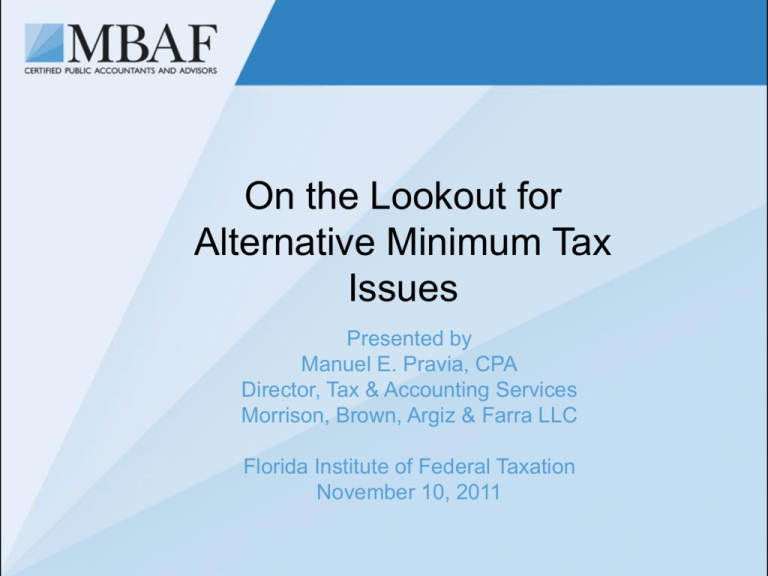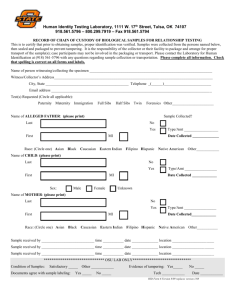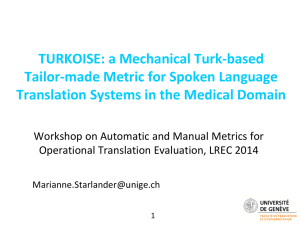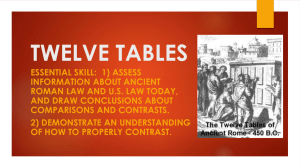On the Lookout for Alternative Minimum Tax Issues
advertisement

On the Lookout for Alternative Minimum Tax Issues Presented by Manuel E. Pravia, CPA Director, Tax & Accounting Services Morrison, Brown, Argiz & Farra LLC Florida Institute of Federal Taxation November 10, 2011 About the Presenter Manuel E. Pravia, CPA, is a Director in the Tax & Accounting Services department of Morrison, Brown, Argiz & Farra, LLC. His experience since 1991 spans various industries, such as insurance and financial institutions, as well as international tax (including corporate, foreign nationals, and expatriates). He also focuses on corporate tax accounting issues (now ASC 740), an area that he dealt with extensively during his ten years of experience at several prominent South Florida companies. Manny regularly presents at continuing professional education seminars and has been an instructor for Becker CPA Review. He is also an adjunct professor in the FIU School of Accounting. Morrison, Brown, Argiz & Farra, LLC is one of the nation's Top 40 certified public accounting and advisory firms and the largest Florida-based accounting firm in the state. Ranked for the last 15 years as one of the top 25 performing firms in the country on INSIDE Public Accounting's "Best of the Best" list, MBAF provides value-added assurance, domestic and international tax services and management advisory services such as litigation support, business consulting and technology solutions to entrepreneurs, privately-held businesses, wealthy individuals, family groups, private and public corporations, exempt organizations and legal practitioners across a broad range of industries. More than 400 highly-qualified partners and employees serve domestic and international clients in more than 45 states and 44 countries from offices in Miami, New York, Baltimore, Boca Raton, Boulder, Fort Lauderdale, Orlando, Valhalla (NY) and Ahmedabad (India). For more information about the Firm, visit http://www.mbafcpa.com. 1 Disclaimer This document is a general discussion. The outcome of any specific matter depends upon the specific facts and circumstances. The information presented is not a substitute for professional advice. The views expressed do not necessarily represent MBAF’s views or policies. Pursuant to Internal Revenue Service Circular 230, you are hereby informed that any tax advice set forth herein with respect to U.S. federal tax issues was not intended or written to be used, and cannot be used, by you or any taxpayer, for the purpose of avoiding any penalties that may be imposed on you or any other person under the Internal Revenue Code. 2 Overview Purpose: generate tax revenue from taxpayer that would otherwise not be in a tax-paying position It is separate from, but parallel to, the regular income tax system. AMT computation reconciles taxable income, through adjustments and preferences, with Alternative Minimum Taxable Income (AMTI) 3 AMT Adjustments Most relate to timing differences Eventually reverse; current positive adjustments will be offset by negative adjustments in the future, and vice versa Depreciation Percentage completion v. completed contract Rationale: eliminate acceleration of some benefits which, though allowable by tax law, are income (and therefore tax) deferrals 4 Fixed assets Adjustment arises from different life/method (convention same) Pre-1986: no adjustment Post-1986 personal property depreciation AMT: 150% DB over ADS life (post 98=MACRS life) Regular tax: Generally 200% DB Post-1986/pre-1999 real property depreciation AMT: straight-line over 40 year life Regular tax: straight-line over 27.5, 31.5, or 39 yrs 5 Fixed assets (cont.) Special (Bonus) Depreciation Allowance §168(k) allowed for AMT No adjustment triggered §179 depreciation rules apply No adjustment triggered 6 Fixed assets (cont.) Since the adjusted basis of an asset can be different for regular tax and AMT, gain or loss recognized upon the disposition of an asset would vary for the two tax systems Difference between regular tax gain (loss) and AMT gain (loss) is an AMT adjustment (positive or negative). This AMT adjustment would completely offset the cumulative prior AMT adjustments 7 Construction contracts Regular tax allows completed contract method for certain long term contracts AMT only allows percentage of completion for all long term contract. AMT adjustment triggered Negative in initial years when income is reported on percentage of completion method under AMT Positive (reversing) when income is greater for regular tax due to recognition of revenue from completed contract 8 Other adjustments Pollution control facilities Regular: Amortize over 60 mos. AMT: depreciate under ADS over MACRS life Mining exploration, development costs and research/experimental expenditures Regular: immediate expense AMT: Amortized over 10 years 9 Preferences Designed to permanently take back all (or part of) tax benefits obtained from certain items for regular income tax purposes Preferences are only positive Addback increases AMTI, effectively disallowing those tax benefits for AMT 10 Examples of preferences Percentage depletion in excess of basis Excess intangible drilling costs Excess of accelerated over straight-line depreciation on pre-1987 real property Excess of amortization over depreciation on pre1987 certified pollution control facilities 7% of the exclusion from gross income of gains on the sale of certain small business stock 11 Preferences: Private activity bonds Municipal bond proceeds of which are used by private entity “Qualified” PABs are exempt for regular tax For AMT, preference item; added back to income and therefore taxed 2009/2010 issues: not preference items 12 Corporate-only items Adjusted Current Earnings adjustment 75% of difference between AMTI and “earnings and profit” driven system Adjustment can be positive or negative oNegative adjustment limited aggregate positive adjustments in prior years 13 ACE Adjustments Depreciation Not applicable post 1993 Income from state and local bonds except bonds Not applicable for 2009/2010 issuances Life insurance proceeds in excess over basis 14 Corporation AMT calculation Exemption amount = $40,000 Phase-out: 25% of amount by which AMTI exceeds $150,000 Tax is a flat 20% rate AMT is a prepayment of corporate tax; 100% available in future as credit Need to consider AMT when calculating estimated taxes; otherwise, exposed to underpayment penalty 15 Small corporations 3-year average annual gross receipts less than $7.5 million AMT repealed post-1997 16 ASC Topic 740 Generally, not an income tax expense – more like a prepaid tax as a future tax benefit is available Realizability of this deferred tax asset is generally “more likely than not” unless entity not expected to be in regular tax position Going concern Preference items 17 AMT Adjustments - Individuals Certain AMT adjustments permanently eliminate otherwise allowable individual tax benefits All state/local taxes and real estate taxes oIf gross income includes a refund of taxes, a negative AMT adjustment is allowed Miscellaneous itemized deductions subject to the 2% AGI limit Medical expense floor increased to 10% (from 7.5%) Standard deduction Personal/dependency exemptions 18 AMT for Individual Progressive rate structure 26% on first $175,000 ($87,500 for MFS) of tax base 28% on remaining amount of tax base AMT Credit: Only allowed to the extent of AMT attributable to timing differences Cannot be carried back Indefinite carryforward 19 The Infamous AMT Patch Exemption amount not indexed for inflation But for Congressional action, many taxpayers would have been subject Income $75,000$100,000 $100,000$200,000 $200,000$500,000 Year Year Year 2000 2005 2010 2.3% 14.7% 29.3% 5.7% 16.1% 35.6% 18.8% 34.0% 64.0% 20 Net Operating Loss (NOL) Separate/parallel system, but concept is same as regular tax Carryback 2 years oElection to forego the NOL carryback for regular tax purposes also applies for AMT purposes oCannot be decoupled Carryforward 20 years 21 Net Operating Loss (NOL) Alternative tax NOL deduction (ATNOLD) cannot offset more than 90% of AMTI. Does not apply to ATNOLDs for which extended carryback was elected in 20082009 oWorker, Homeownership, Business Assistance Act (WHBAA) or American Recovery and Reinvestment Act (ARRA) 22 AMT Considerations Leasing rather than purchasing to avoid depreciation adjustment (temp) Invest in tax-exempt bonds that are not also private activity bonds (perm) 23 When all else fails… If expectation is that AMT will be applicable on a yearly basis, plan timing of preferences and permanent adjustments Put off/speed up state tax payments Take advantage of rate differential between regular income tax and the AMT in AMT years. 24 Q&A








